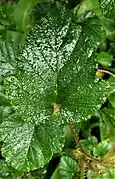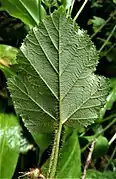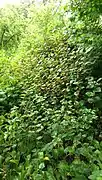Rubus tricolor
Rubus tricolor (/ˈruːbəs ˈtraɪkʌlər/)[3][lower-alpha 1] is an evergreen prostrate shrub, native to southwestern China. Leaves are dark green above, pale green below, and stems have red bristles. It has white flowers in summer, and edible red fruit. It grows approximately 0.3 m (1 ft) high and usually forming a vigorously spreading, dense mat. In cultivation it is mainly used as groundcover. Common names include Chinese bramble,[4] groundcover bramble,[4] creeping bramble,[5] Korean raspberry,[3] Himalayan bramble,[6] Groundcover Raspberry.[7] In Chinese it is called 三色莓 ("sān sè méi").[8]
| Rubus tricolor | |
|---|---|
 | |
| Scientific classification | |
| Kingdom: | Plantae |
| Clade: | Tracheophytes |
| Clade: | Angiosperms |
| Clade: | Eudicots |
| Clade: | Rosids |
| Order: | Rosales |
| Family: | Rosaceae |
| Genus: | Rubus |
| Species: | R. tricolor |
| Binomial name | |
| Rubus tricolor | |
| Synonyms[2] | |
| |
Description
Morphology
The growth habit is prostrate / procumbent (trailing along the ground), but also climbing.[8] It is usually stated to be an evergreen shrub,[4][5][9] but sometimes said to be semi-evergreen,[3] or deciduous.[10] This is because it is normally evergreen but can shed its leaves in severe winters.[5] The long stems arch between 30 cm (~1 ft) and 60 cm (~2 ft) high,[5] although it may get higher if it grows over itself or other shrubs.[4] The tips root when they touch the ground.[4] It grows at a fast rate,[5] spreading up to 2 m (6 ft 6 inches) per year.[4] It tends to form a dense, creeping mat,[3] of sprawling shrubs growing into each other.[11]
The stems are tomentose, having dense yellow-brown bristles, but are not prickly. Leaf petioles are 1.5-4 cm long, and similarly bristled, with glandular hairs and persistent stipules approximately 1–2 cm by 4–8 mm.[3][8]
Leaves are alternate (each leaf arises at a different node).[3] Leaf shape is simple (undivided blade) or slightly undulate (3-5 shallow lobes), ovate to oblong, with base subrounded to cordate and apex shortly acuminate (see: Leaf shapes).[8][9][12] More simply, leaves have a heart-shaped base and a pointed tip.[3] The margins of the leaf are described as unevenly coarsely sharply serrate (see: Leaf margin). Leaves are approximately 6–12 by 3–8 cm in size. On the abaxial (under) surface, the colour is yellow-grey and there are bristles, particularly on the veins which are raised. Adaxially (upper surface), the leaf is dark green, glossy and mostly glabrous (hairless) with only sparse bristles between veins.[8]
Flowers are white, about 2.5 cm wide, solitary or in small clusters.[8]
Fruit are aggregate drupelets, bright red, and subglobose (imperfectly rounded), about 1.5–1.7 cm in diameter.[8]
.JPG.webp) Growing tip of shoots
Growing tip of shoots Leaf (abaxial surface)
Leaf (abaxial surface) Leaf (adaxial surface)
Leaf (adaxial surface).JPG.webp) Stem. Note alternate leaf pattern
Stem. Note alternate leaf pattern.JPG.webp) Stem (under surface)
Stem (under surface) Typical growth habit, creeping dense mat
Typical growth habit, creeping dense mat Forest garden groundcover
Forest garden groundcover
Taxonomy
"Discovery" of R. tricolor is credited to Père Jean Marie Delavay,[13][lower-alpha 2] and first introduced from China to the west in 1908 by plant collector Ernest Henry Wilson.[3] It was provisionally described as a species by Wilhelm Olbers Focke in 1910.[1] David Prain formally recognized it as an accepted species in a supplement to Index Kewensis in 1913.[14]
R. tricolor is a member of the genus Rubus which contains about 250 species, including the many different species of blackberries, raspberries and dewberries. Rubus is contained within the family Rosaceae (the "rose family").
Rubus means "bramble" or "bramble-like" in ancient Latin, and in Botanical Latin, tricolor means "three-coloured".[15] Focke conferred that epithet based on the three colours of the plant: leaves green above, white below, and the red bristles of the stems and petioles.[1]
Distribution and habitat
Ecology
Growth cycles
R. tricolor flowers in July.[5] It is hermaphrodite (has both male and female organs),[5] but is self-sterile (one plant will not fruit by itself).[4] It is insect pollinated,[5] and the fruit ripens from mid-July to September.[4] The plant fruits only occasionally.[6] Many Rubus species rely on birds (and mammals) to eat the fruit, which contain seeds. Stomach acids scarify the hard outer shell of the seed, leaving the seed within intact.[16] The seed is deposited in the animal droppings which helps to disperse the plant and may also act as a fertiliser (see: seed dispersal).
Pests and diseases
R. tricolor is generally not troubled by pests.[9] Grey mould (Botrytis cinerea) may sometimes infect it.[9] Honey fungus (Armillaria) is a problem for many Rubus species.[5]
Cultivation
R. tricolor is a tough plant, easily cultivated and low maintenance.[9][11] The species is cold hardy to about -15°c,[5] meaning it can be grown in United States hardiness (USDA) zones 6-9,[5] and it has a Royal Horticultural Society hardiness rating of "H5".[9] R. tricolor will grow in well-drained soil, but will tolerate moist soil as long as it is fairly well drained.[9] It tolerates a variety of soils such as chalky or sandy soils, but prefers loam; and tolerates acid, neutral or alkaline soils.[9] The plant grows best in partial shade but will also grow in deep shade or full sun.[5]
It is widely used as a groundcover plant to suppress weeds,[11][17] and protect soil.[18] Since it is very vigorous,[19] and fast growing it is more suited to larger areas,[11] and is said to be too vigorous for small gardens.[4] Since it is tolerant of deep shade and has edible fruit, it has been recommended by proponents of forest gardening as a good groundcover plant under trees.[4][20][19][18][21] Despite forming a dense groundcover, in the absence of a canopy layer R. tricolor will still be invaded by prolific seeding tree species such as ash (Fraxinus excelsior), sycamore (Acer pseudoplatanus) and elder (Sambucus nigra).[17] Some advise against planting R. tricolor with any plants smaller than trees because it will tend to smother them.[5][19]
Propagation is usually done by tip layering (in July),[5] softwood cuttings (in summer), or hardwood cuttings (in winter).[9] Division is usually done in early spring.[5] Seed requires stratification to simulate exposure to a cold weather and trigger germination. Some advise to sow in early autumn in a cold frame. Stored seed is sown early in the year in a cold frame. Stratification of 1 month at 3°c is carried out (if sown later than February).[5]
‘Betty Ashburner’ (Rubus x 'Betty Ashburner') is a hybrid of Rubus tricolor and Rubus calycinoides,[lower-alpha 3][22] sometimes referred to as "Creeping Raspberry",[23] although that term is also used to refer to a few other Rubus species, including the parents of the hybrid.
Uses
The fruits are edible raw or cooked, and are generally treated in the same manner as raspberries.[7] They are usually eaten raw because they have limited shelf life once harvested.[7] Fruit can also be made into jam.[7]
A purple - blue dye can be made from the fruit.[5]
The flowers also provide forage for bees.[4]
Notes
- Pronunciation of Botanical Latin is variable.
- Presumably the people inhabiting the native range of the plant already being aware of it.
- Sometimes given as R. calycinoides, R. pentalobus or R. rolfe, this parent of the hybrid is correctly referred to as R. hayata-koidzumii.
References
- Focke, Wilhelm Olbers (1910). "Species Ruborum". Bibliotheca Botanica. 17 (72): 40.
- "Rubus tricolor Focke ex Prain (Plants of the World Online)". Plants of the World Online. Kew Science. Retrieved 1 June 2019.
- "Rubus tricolor". landscapeplants.oregonstate.edu. Oregon State University. Retrieved 1 June 2019.
- Crawford, M (2010). Creating a Forest Garden: Working with Nature to Grow Edible Crops. Green Books. p. 206. ISBN 9781900322621.
- "Rubus tricolor - Focke". pfaf.org. Plants For A Future Plant Database. Retrieved 1 June 2019.
- Tenaqiya, R (2004). West Coast food forestry: a permaculture guide. p. 115. OCLC 402273566.
- Crawford, M; Aitken, C (2013). Food from your forest garden: how to harvest, cook and preserve your forest garden produce. Green Books. p. 230. ISBN 9780857841124. OCLC 833278613.
- "Rubus tricolor (Flora of China)". www.efloras.org. Flora of China. Retrieved 1 June 2019.
- "Rubus tricolor (Chinese bramble)". Royal Horticultural Society. Retrieved 1 June 2019.
- Fang, J; Wang, Z; Tang, Z (2011). Atlas of Woody Plants in China: Distribution and Climate (in Chinese). Springer Science & Business Media. p. 609. ISBN 9783642150173.
- Forrest, M (2006). Landscape Trees and Shrubs: Selection, Use and Management. CABI. pp. 19, 122, 136, 144. ISBN 9781845930547.
- Stace, C (2010). New Flora of the British Isles. Cambridge University Press. p. 244. ISBN 9781139486491.
- Lancaster, R (2008). Plantsman's Paradise: Travels in China. Garden Art Press/Antique Collecters' Club. p. 202. ISBN 9781851495153.
- Prain, David, ed. (1913). Index Kewensis supplement 4. Oxford: Clarendon Press. p. 207.
- Gledhill, D (2008). The Names of Plants. Cambridge University Press. pp. 335, 386. ISBN 9780521866453.
- "Rubus bartonianus (Bartonberry)". Institute for Applied Ecology. 9 October 2014. Retrieved 1 June 2019.
- Robinson, N (2004). The Planting Design Handbook. Ashgate Publishing, Ltd. pp. 145, 151. ISBN 9780754630357.
- Whitefield, P (1996). How to Make a Forest Garden. Permanent Publications. p. 58. ISBN 9781856230087.
- Woodland Gardening: designing a low-maintenance, sustainable edible woodland garden with fruit and nut trees, shrubs, herbs, vines and perennial vegetables. Plants For A Future. 2013. p. 65. ISBN 9781484069165.
- Jacke, D; Toensmeier, E (2008). Edible forest gardens. Vol. 2. pp. 293, 498, 501, 551. ISBN 9781931498807. OCLC 872196417.
- Hart, R (1996). Forest Gardening: Rediscovering Nature & Community in a Post-industrial Age. Green Earth. p. 167. ISBN 9781900322027.
- Hatch, LC (2015). Cultivars of Woody Plants: Genera R. TCR Press. ISBN 9780881922509.
- Annual Report. Cornell University, Long Island Horticultural Research & Extension Center. 2005.